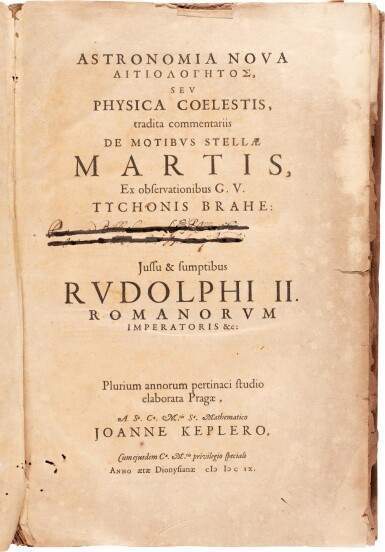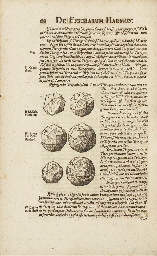KEPLER, Johannes. Astronomia nova AITIOLOGHTOS, seu physica coelestis, tradita commentariis de motibus stellae martis, ex observationibus G. V. Tychonis Brahe . [Heidelberg: E. Vögelin,] 1609.
KEPLER, Johannes. Astronomia nova AITIOLOGHTOS, seu physica coelestis, tradita commentariis de motibus stellae martis, ex observationibus G. V. Tychonis Brahe . [Heidelberg: E. Vögelin,] 1609. 2° (369 x 247 mm). Folding letterpress synoptic table, dedication to Emperor Rudolph II, approximately 300 woodcut text diagrams (many repeated), woodcut initials, head- and tail-pieces. (Lacking three preliminary blanks, some browning as usual, some marginal worming, occasionally affecting letters, heavier towards the end.) 19th-century calf (worn, spine perished). Provenance: Lous de Machaule (1611 inscription on title); H. DeRefuge (signature on title). FIRST EDITION OF KEPLER'S MOST IMPORTANT WORK, A CORNERSTONE OF MODERN ASTRONOMY, containing the first enunciation of the first two laws of planetary motion: the law of elliptical orbits, and the law of equal area (the radius vector drawn from the sun to a planet describes equal areas in equal times). In 1599, expelled from Graz along with other Protestant teachers, Kepler had spent three months with Brahe at his Benatky Castle observatory in Prague. There, "by Divine Providence," as Kepler later viewed it, Tycho assigned him to come up with a theory of Mars. Kepler had expected this task to be the work of a few weeks; instead he pursued it, with some interruptions, for the next five years. The mass of systematic and accurate observational data collected by Brahe, who died in 1601, forced Kepler, through its own "inexorable logic," to elaborate an entirely new astronomical system. He presented his revolutionary conclusions in the aptly titled Astronomia nova. "Copernicus had shown the sun to be the centre of the universe round which the earth and planets revolve, but his description of their movements was still strongly influenced by ancient conceptions of order and harmony. It was Kepler's aim to determine the true movements of the planets and the mathematical and physical laws controlling them" ( PMM ). As Kepler phrased it, his goal was "to replace a theology or metaphysics of the heavens with a philosophy or physics of the heavens," and to show that "the celestial machine is like a clockwork" (Caspar). "Copernicus had referred planetary motions to the center of the earth's orbit, but Kepler referred them to the sun itself, therefore paving the way for a real center of force and making possible the Newtonian celestial mechanics" (Dibner). The work was finished in 1605, but publication was delayed, partly due to a lack of imperial financial support, but also because of contestation by Tycho Brahe's heirs, who had been short-changed by the Emperor of a promised sum for Tycho's manuscripts, and who thus had a vested interest in Brahe's data. One of them, Tycho's son-in-law Franz Gansneb Tengnagel, "although unqualified, promised his own publication and, after failing to produce, threatened to suppress Kepler's commentary... A compromise was reached: Tengnagel was allowed a preface to warn the reader not to 'become confused by the liberties that Kepler takes in deviating from Brahe in some of his expositions, particularly those of a physical nature'" ( DSB ). Tengnagel's note to the reader appears on fol. (***)1v. In 1607 Kepler had had the wood blocks cut in Prague, and in 1608 he sent the text to be printed by E. Vögelin in Heidelberg. The absence of an imprint was due to the fact that the edition was not intended for commerce: the Emperor held the rights to its distribution, since Kepler had written it in his post of court astronomer and it had been printed at imperial expense. Kepler however thought otherwise, his salary being long in arrears, and he sold his copies to the publisher. Although the size of the press run is not recorded, Kepler later stated that only "a few copies" had been printed (Caspar p. 55). Caspar 31; Dibner Heralds of Science 9; Grolier/Horblit 57; Houzeau & Lancaster 11830; Norman 1206; PMM 112.
KEPLER, Johannes. Astronomia nova AITIOLOGHTOS, seu physica coelestis, tradita commentariis de motibus stellae martis, ex observationibus G. V. Tychonis Brahe . [Heidelberg: E. Vögelin,] 1609.
KEPLER, Johannes. Astronomia nova AITIOLOGHTOS, seu physica coelestis, tradita commentariis de motibus stellae martis, ex observationibus G. V. Tychonis Brahe . [Heidelberg: E. Vögelin,] 1609. 2° (369 x 247 mm). Folding letterpress synoptic table, dedication to Emperor Rudolph II, approximately 300 woodcut text diagrams (many repeated), woodcut initials, head- and tail-pieces. (Lacking three preliminary blanks, some browning as usual, some marginal worming, occasionally affecting letters, heavier towards the end.) 19th-century calf (worn, spine perished). Provenance: Lous de Machaule (1611 inscription on title); H. DeRefuge (signature on title). FIRST EDITION OF KEPLER'S MOST IMPORTANT WORK, A CORNERSTONE OF MODERN ASTRONOMY, containing the first enunciation of the first two laws of planetary motion: the law of elliptical orbits, and the law of equal area (the radius vector drawn from the sun to a planet describes equal areas in equal times). In 1599, expelled from Graz along with other Protestant teachers, Kepler had spent three months with Brahe at his Benatky Castle observatory in Prague. There, "by Divine Providence," as Kepler later viewed it, Tycho assigned him to come up with a theory of Mars. Kepler had expected this task to be the work of a few weeks; instead he pursued it, with some interruptions, for the next five years. The mass of systematic and accurate observational data collected by Brahe, who died in 1601, forced Kepler, through its own "inexorable logic," to elaborate an entirely new astronomical system. He presented his revolutionary conclusions in the aptly titled Astronomia nova. "Copernicus had shown the sun to be the centre of the universe round which the earth and planets revolve, but his description of their movements was still strongly influenced by ancient conceptions of order and harmony. It was Kepler's aim to determine the true movements of the planets and the mathematical and physical laws controlling them" ( PMM ). As Kepler phrased it, his goal was "to replace a theology or metaphysics of the heavens with a philosophy or physics of the heavens," and to show that "the celestial machine is like a clockwork" (Caspar). "Copernicus had referred planetary motions to the center of the earth's orbit, but Kepler referred them to the sun itself, therefore paving the way for a real center of force and making possible the Newtonian celestial mechanics" (Dibner). The work was finished in 1605, but publication was delayed, partly due to a lack of imperial financial support, but also because of contestation by Tycho Brahe's heirs, who had been short-changed by the Emperor of a promised sum for Tycho's manuscripts, and who thus had a vested interest in Brahe's data. One of them, Tycho's son-in-law Franz Gansneb Tengnagel, "although unqualified, promised his own publication and, after failing to produce, threatened to suppress Kepler's commentary... A compromise was reached: Tengnagel was allowed a preface to warn the reader not to 'become confused by the liberties that Kepler takes in deviating from Brahe in some of his expositions, particularly those of a physical nature'" ( DSB ). Tengnagel's note to the reader appears on fol. (***)1v. In 1607 Kepler had had the wood blocks cut in Prague, and in 1608 he sent the text to be printed by E. Vögelin in Heidelberg. The absence of an imprint was due to the fact that the edition was not intended for commerce: the Emperor held the rights to its distribution, since Kepler had written it in his post of court astronomer and it had been printed at imperial expense. Kepler however thought otherwise, his salary being long in arrears, and he sold his copies to the publisher. Although the size of the press run is not recorded, Kepler later stated that only "a few copies" had been printed (Caspar p. 55). Caspar 31; Dibner Heralds of Science 9; Grolier/Horblit 57; Houzeau & Lancaster 11830; Norman 1206; PMM 112.


.jpg)



.jpg)

.jpg)



.jpg)

Testen Sie LotSearch und seine Premium-Features 7 Tage - ohne Kosten!
Lassen Sie sich automatisch über neue Objekte in kommenden Auktionen benachrichtigen.
Suchauftrag anlegen